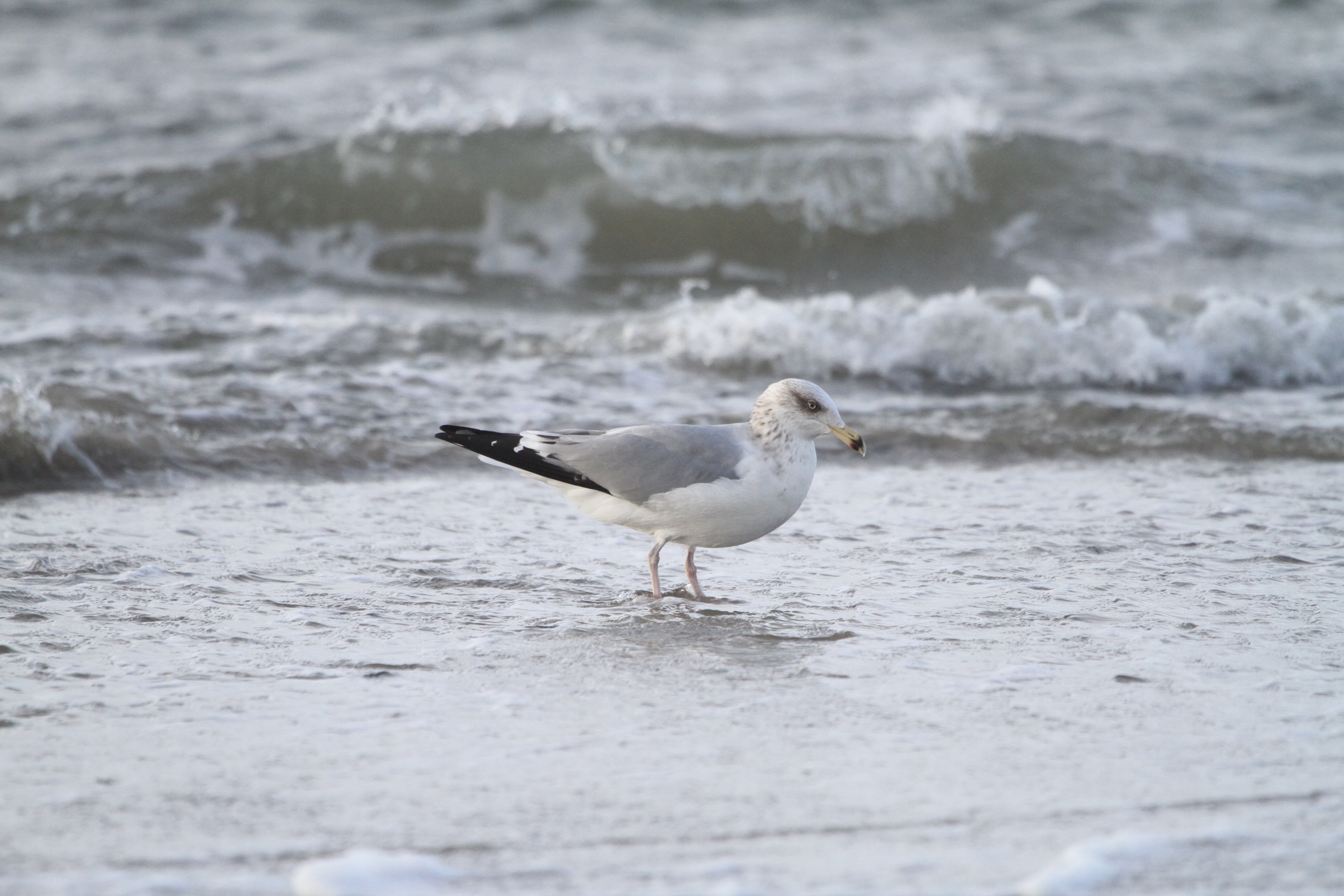Her på Blåvand's blog bringes korte nyheder i dagbogsformat om livet og hændelser på fuglestationen.
Se indlæg fra måned: feb. (2)mar. (31)apr. (30)maj (31)juni (10)juli (22)aug. (31)sept. (30)okt. (31)nov. (15)dec. (1)
1000 tits and a special surprise!
Morning Observation
Today we were contemplating even going out, due to the bad weather that was promised. But we took on our boots, jackets and most importantly, our optics. A slow rain fell on us as we got ready for the day. The birds migrated slowly but promisingly, oddly enough allot of the auks went north instead og south. Yesterday at night the wind was strong, which could have blown the birds off course, leading them to go north instead of south this morning. The birds of today were a mix of, Northern pintale in fair numbers, and starlings, in what i would call, huge numbers, with a flock of 3000 birds passing eary in the morning. For many people seeing a little auk is a great and rare experience, but for us the observers we have seen them for four straight days. Some days with less than five, and one great day with 15 little auks. In the beginning we would yell "LITTLE AUK", and now we just say "oh theres another one". But soon before we know it we will be missing the little auks, when the migration stops and the cold winter takes over and halts the birds in their path.
- OLA
Ringing
What seemed to be a rained of day, turned out to be very special day in many days! Do you prioritize quantety or rarity? Either way, today we got both! We have officialy ringed 1.000 blue tits (blåmejse)! And to top it of, we got our second Pallas leaf-warbler (fuglekongesanger) of the season!
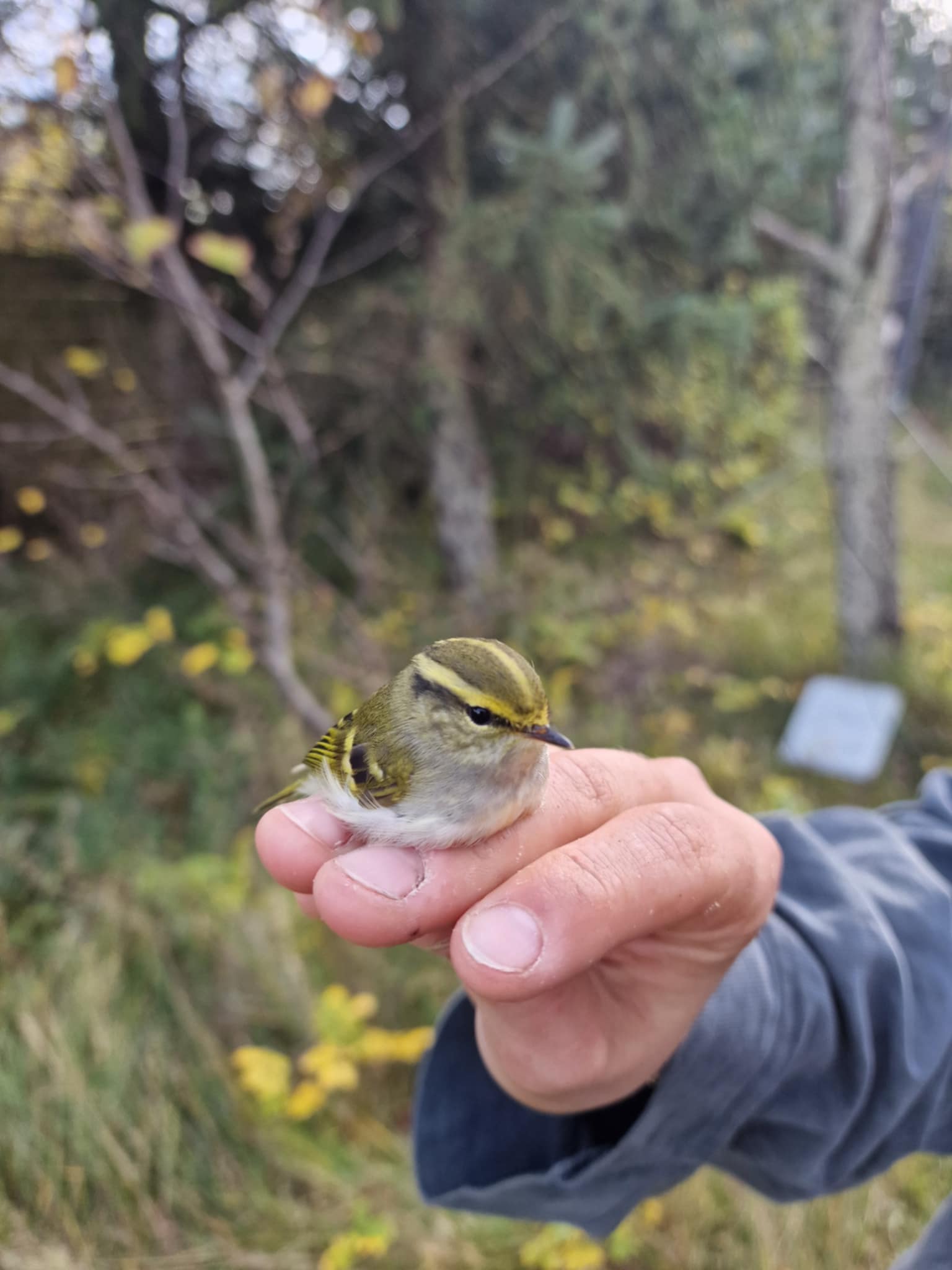
The rest of the day calmed down again due to the colder winds and rain showers. However we did get a good number of blackbirds as well and saw alot of blue tits hoping around the trees waiting for the rest of the clan to be released, which is always nice to see!
- LK
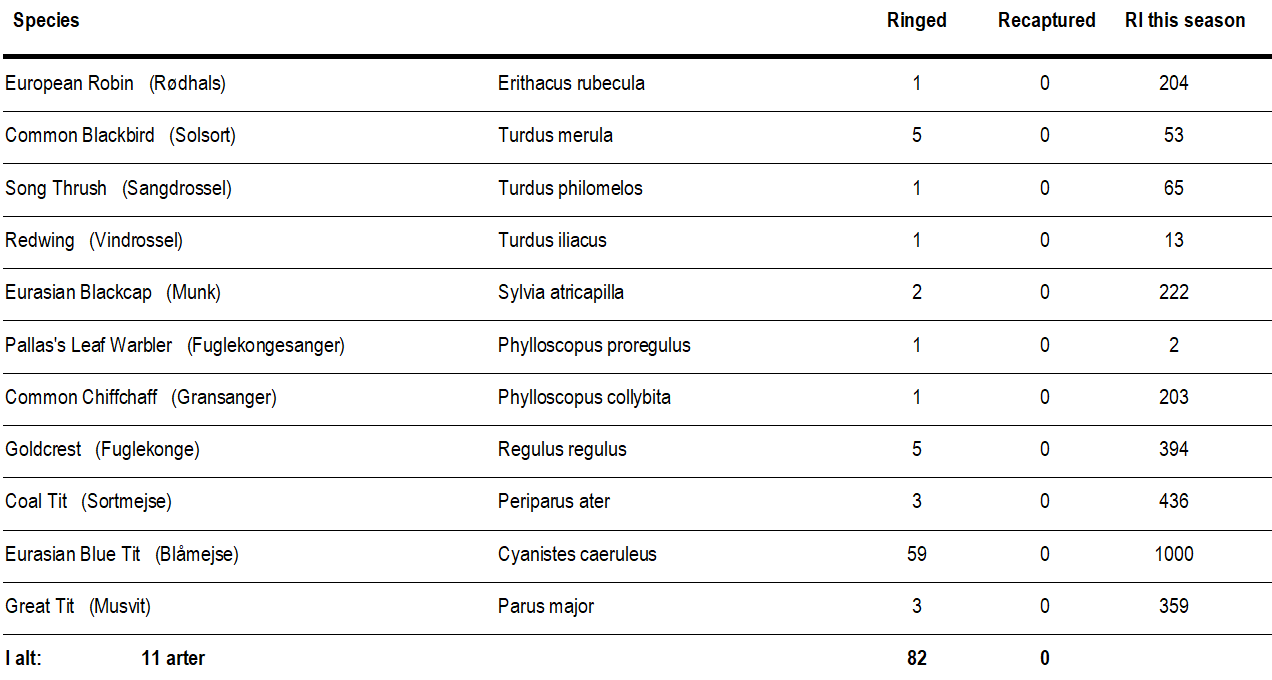
Folk på stationen: Lua Koplin, Sverre Dahl Porsgaard, Mathilde Lundt Larsen, Oliver Laursen
Formidable fugle og mange mejser
Morgenobs
Dagen i dag stod på "dejlig" nordvestenvind. Det er normalt det som vi kalder dræberhjørnet da denne vindretning dræber alt form for spænding. I dag var dog en ganske fin morgen, måske fordi at det havde blæst voldsomt hele natten så trækket først kunne foregå nu. Det blev til en dejlig dag med en fin mængde alkefugle, deriblandt hele 16 søkonger! Foruden søkonger kan nævnes en gråstrubet lappedykker, en gravand, to havlitter og en dværgværling. Nårh ja og så startede dagen med at Henrik Böhmer fandt en sodfarvet skråpe... Det slutter dog ikke her! Mikkel Bello fandt en 3k middelhavssølvmåge. En utrolig lækker fugl som rastede på stranden. Det vil sige at vi igen i dag kan stolr præsentere fire semisjældne fugle, der er dejlig tryk på i de her dage:)
Jeg nåede heldigvis langt de fleste af de gode fugle inden jeg blev tilkaldt til ringmærkningen som backup
Mikkel Bellos lækre 3k middelhavs sølvmåge. Foto; Mikkel Bello.
- SDP
Ringmærkning
Vi stod op til samme tid med solen, men klokken slog anderledes. Solen tog sig dog sin tid om at skinne gennem skyerne i morges, og dagen indledtes derfor med mindre regnskyl, der holdte os i gang med at tjekke nettene. Vi havde et par enkelte fugle fra morgenstunden - rødhals, munk, vindrossel, solsort, dompap og en ny kvækerfinke, som vi har haft et par få af i sæsonen. Denne diversitet faldt drastisk ved næste hændelse.
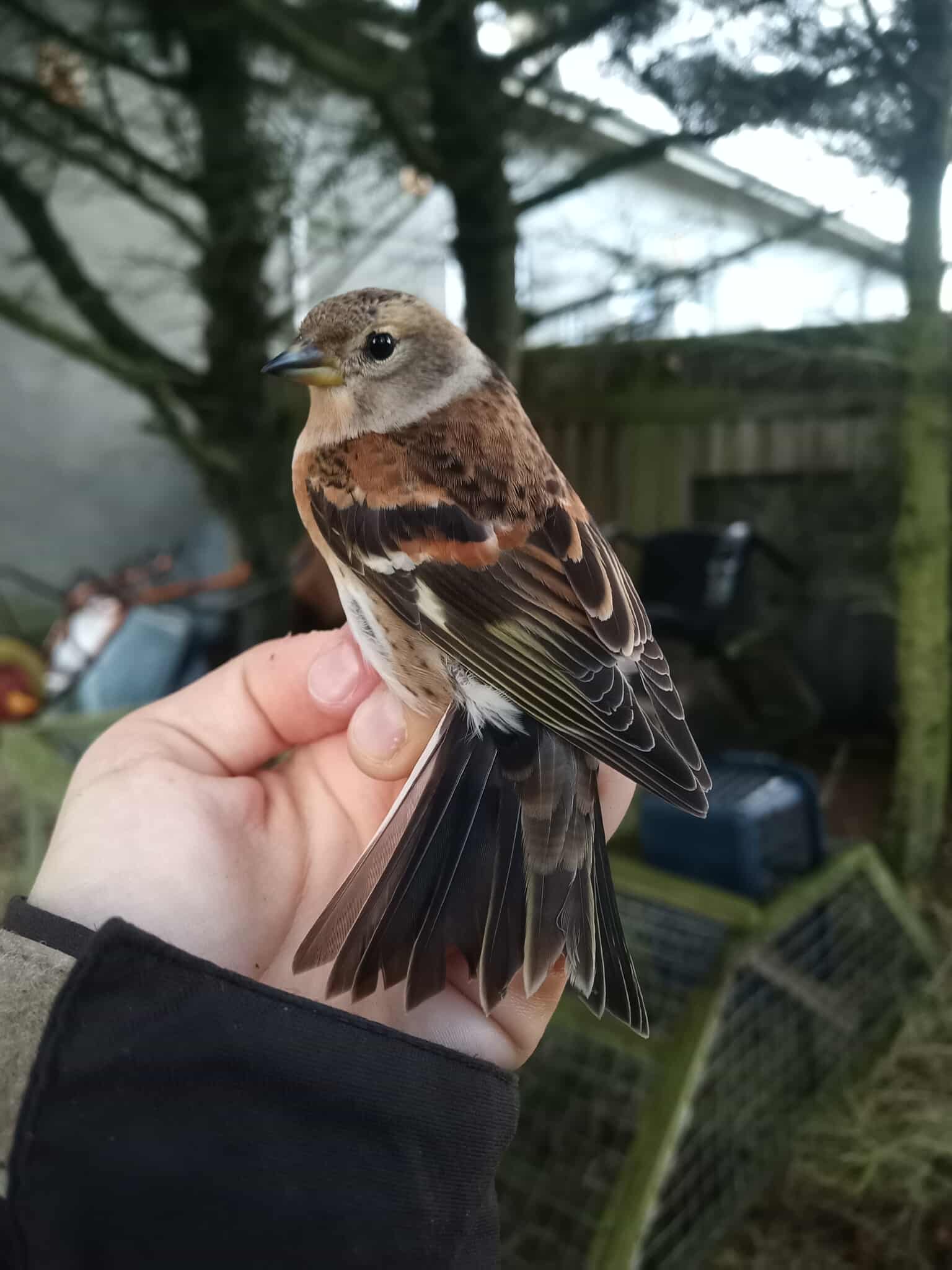
1k kvækerfinke.
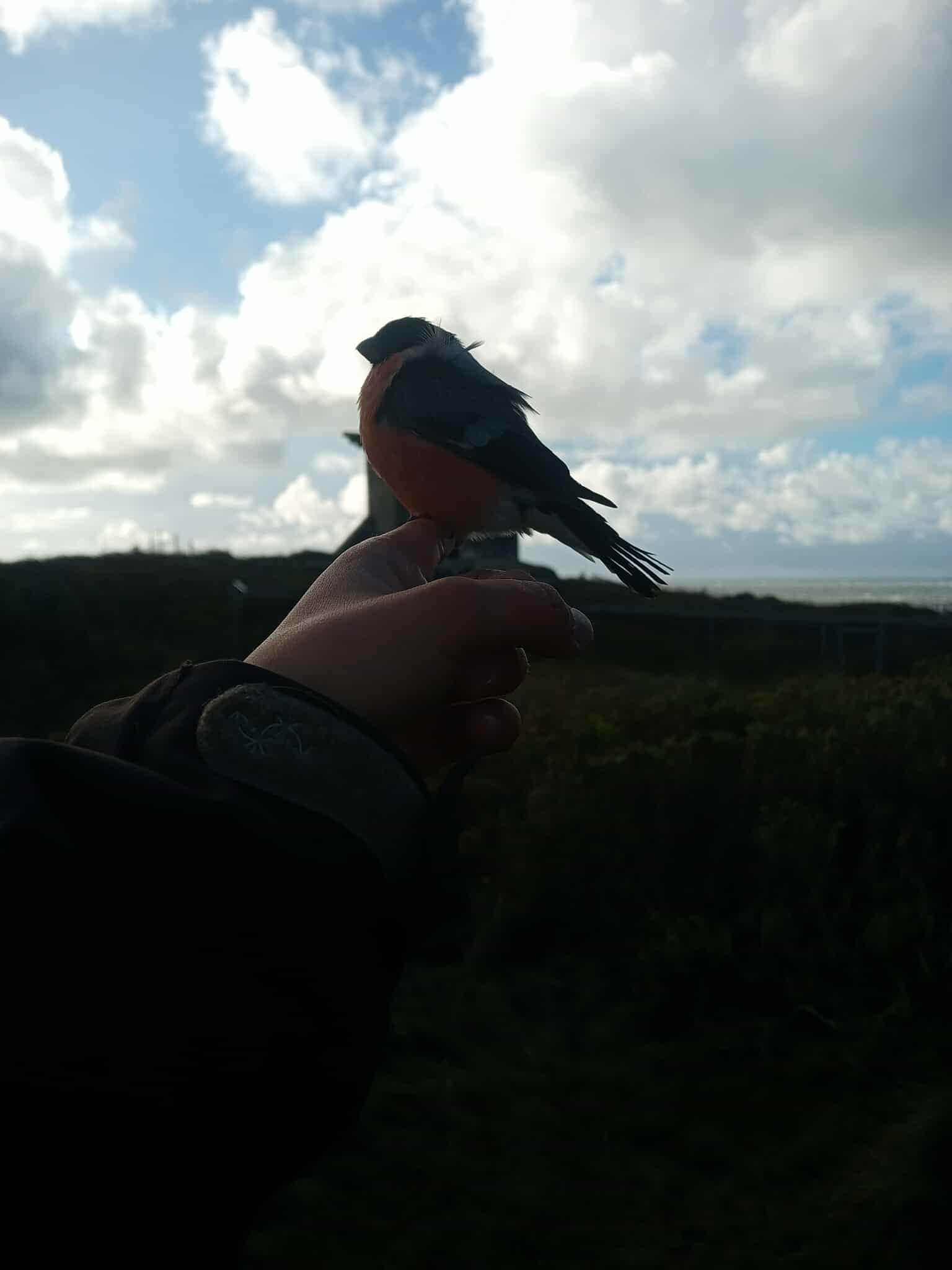
1k dompap han.
Jeg påbegyndte da at sy et net i et hul, men måtte hurtigt efterlade syslerne til en anden dag - for da ramte blåmejserne med et brag i nettene i fyrhaven. Vi startede ud med omkring femten i et net og ti i et andet, men da vi begyndte at tage dem ud, fløj der hurtigt flere omkring ørerne på os. De kaldte fra alle sider i træerne og man kunne stå og næsten få dem i hovedet, mens de fløj ind i nettet. Nogle enkelte satte sig på toppen af netstrengen og kiggede næsten fredfyldt rundt og ned på sine artsfæller.
Vi lukkede de andre net for at kunne fokusere på det ene net, der indeholdte næsten alle blåmejserne og en del musvitter også. Fra dette ene net kunne vi fortsætte de næste tre timer med at pille blåmejser ud, for efterhånden som vi tog dem ud, fløj der så mange nye ind, at man kunne se sig til siderne og knap ane, at man havde arbejdet på det. Trods dette formåede vi at være tre om at ringmærke alle 202 blåmejser (det største antal blåmejser denne sæson på en dag) ved nettet, efterhånden som de fløj ind og holde overblik, så de ikke led overlast. Vi måtte gå struktureret til værks, når der næsten faldt mejser ned fra himlen i nettet og kaldte på hinanden frem og tilbage. De måtte holdes tilbage fra hinanden, mens jeg næsten begravede mig selv i nettet og stak fingrene ned for at blive bidt fra flere sider af mejserne - det stoppede dem fra at bekrige hinanden i hvert fald at de fandt en fælles fjende i mine fingre. Med hurtige hænder og fokuseret arbejde kunne vi i fællesskab fejre at lukke nettet og tælle data for de mange fugle.
Sådan en dag giver ikke en lang artliste, men det giver et stort antal fugle - vi nåede op på 230 ringmærkede fugle i dag, hvoraf langt den største del var de 202 blåmejser. Derudover også en god mængde musvitter (14). Nettet, der skulle sys, må jeg da vende tilbage til i morgen. Glæden over en god ringmærkningsdag holder dog ved - i dag blev dagen med tredjestørste antal fugle i sæsonen, og vi nærmer os 1000 blåmejser for sæsonen.
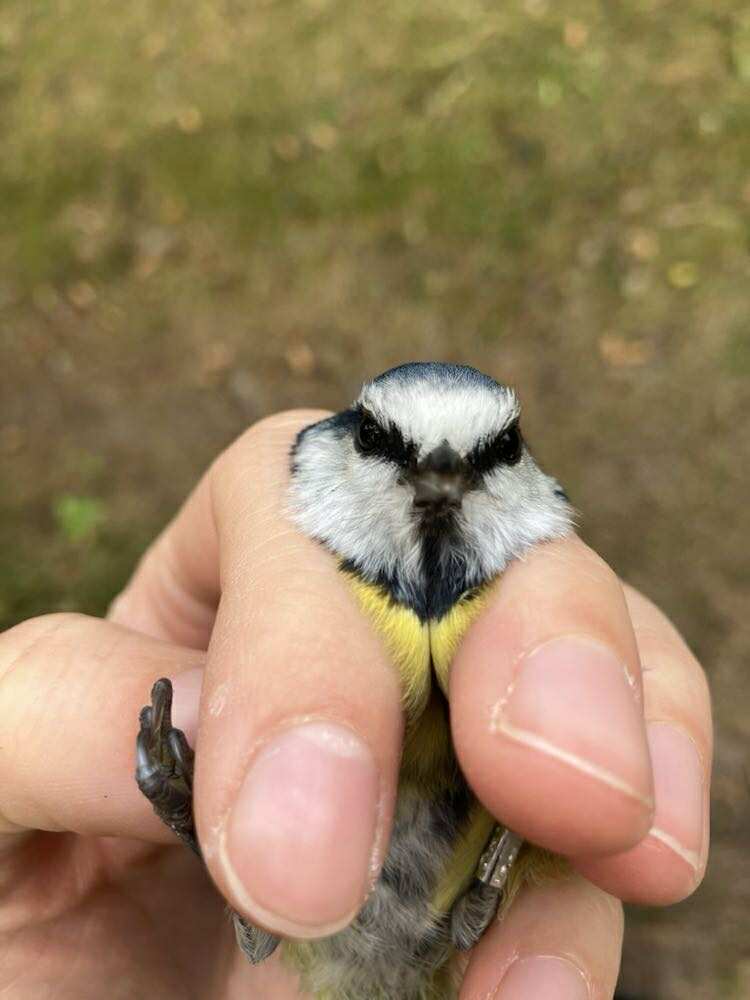
1k blåmejse i hånden, bemærk det bistre udtryk.
- MLL
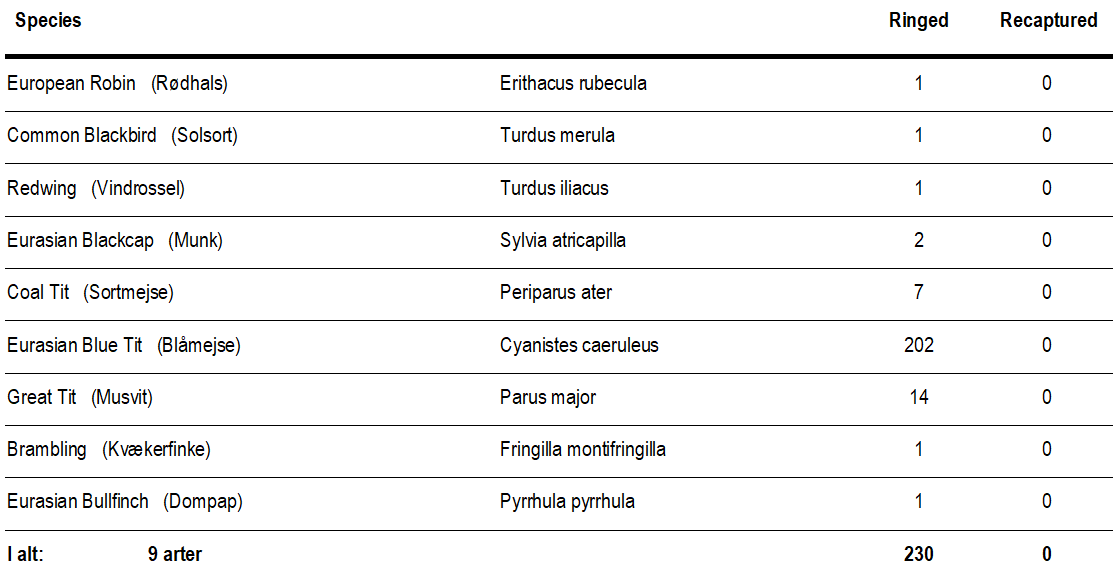
Folk på stationen: Lua Koplin, Sverre Dahl Porsgaard, Mathilde Lundt Larsen, Oliver Laursen, Mikkel Bello, Henrik Böhmer
Som at være tilbage i 1940
Morgenobs
Nu har i sikkert studset over dagens titel, men det er der en god forklaring for. Vejrguderne (DMI) har som altid lagt en plan for dagen i forhold til vind og vejr. Regnen stod på skemaet sammen med en god mængde vind fra SV derefter skiftene til V i eftermiddagen. Dette betød at vi satsede på en god havobs i sabinebunkeren. Vi startede talstærkt med fire mand i bunkeren, hvorefter fire flere kom til efterhånden som dagen gik. Træktællingen blev gennemføret ved standardtid, og gode arter som nordisk lappedykker, dværgmåge og søkonge var dagens fugle. De nordiske lappedykkere kom pænt tæt på med dens hals og flotte hvide vingefelter, dværgmågerne kom mest langt ude, men nogengange kom de i strandkanten hvor de kunne nydes i håndkikkert. Den lille og altid søde søkonge kom i syv eksemplarer, nogle ligesom dværgmågen kom i strandkanten, mens andre kom lidt længere ude og gemte sig bag de store bølger. Alt dette foregik i sabinebunkerens læ for regn og vind. Da morgenbsen var slut tog nogle hjem og fik frokosten med kaffen, andre tog hurtigt ud og handlede. Men hurtigt igen kom vi ud i felten og ledte. Da vi tjekkede DMI igen, så vi at der skulle blæse 13 m/s fra V, hvilket er lig med sabinebunkeren. Anden gang vi tog derud blæste og regnede det meget, og vi kom da ikke helt tørre derned. Her fortsatte trækket faktisk som før med tre søkonger mere, og 190 dværgmåger! Det er flotte tal, og i den gamle hede følte vi os næsten som at være tilbage under bunkernes tid i 1939.
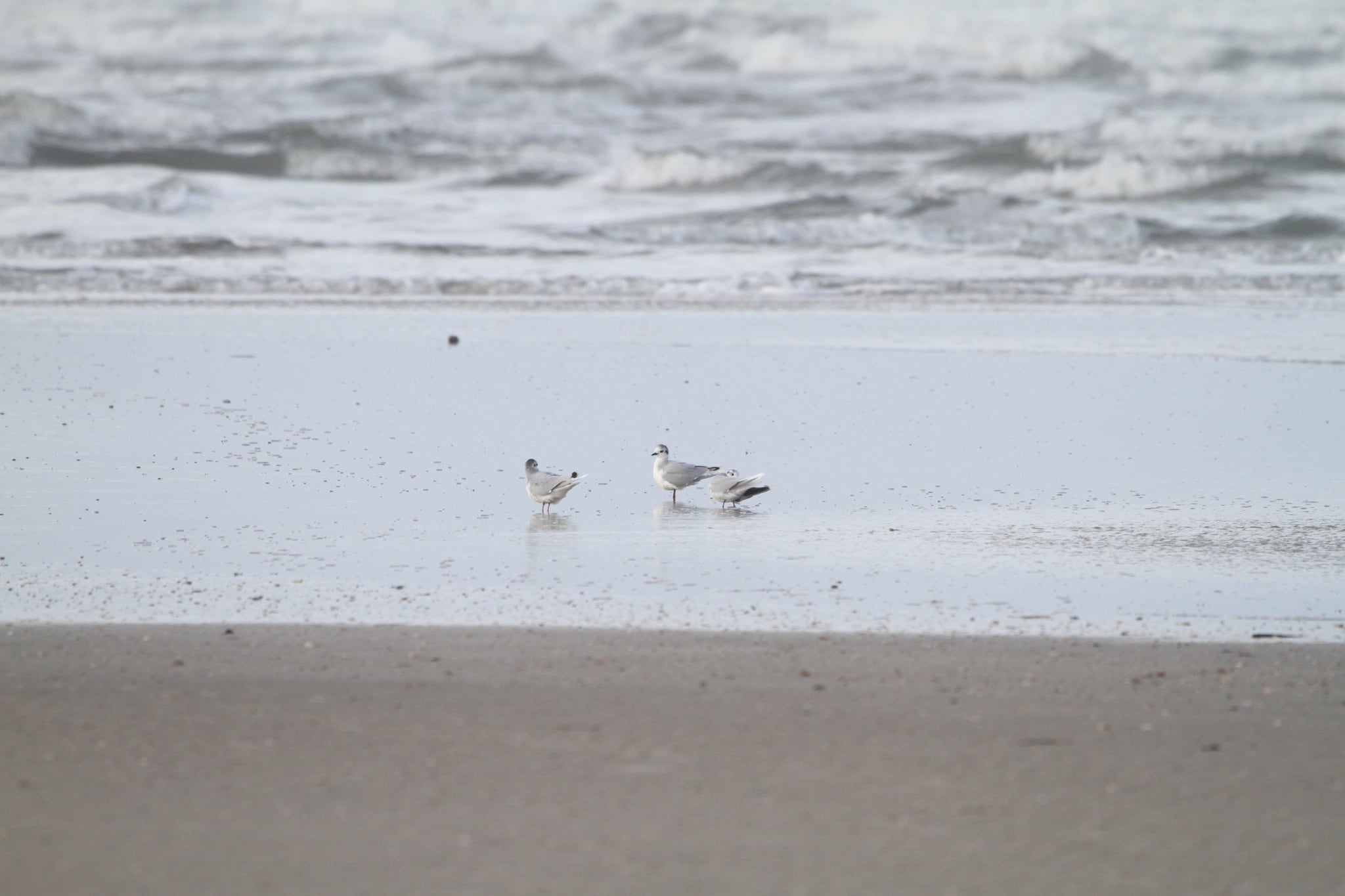
- Tre dværgmåger på stranden, foto; Mikkel Bello
- OLA
Ringmærkning
Grundet vejret var der ikke ringmærkning i dag, og ringmærkerne deltog i morgenobs i stedet.
Folk på stationen: Lua Koplin, Sverre Dahl Porsgaard, Mathilde Lundt Larsen, Oliver Laursen, Mikkel Bello, Henrik Böhmer, Thomas Kristensen
RARE BIRDS AT THE OBS!
Morning Observation
Mmm jeg vågnede her til morgen efter en dårlig nats søvn, så jeg var ikke ligefrem frisk og veludhvilet til dagens obs. Men det omskiftelige vejr lugtede langt væk af sjældne fugle, så det var hurtigst muligt ud af fjerene og op på sandbakken med Oliver og jeg. Herude blev vi mødt af en forbavsende lun vind fra øst, ca 2-4 meter i sekundet som dog ville vise sig at trække meget op i løbet af dagen. Dagen startede godt ud med massere af trækkende sortænder. Jeg vil dog ikke kede hverken jer eller mig selv med sortænder da første sjældne fugl allerede kom kl 08.40. TAJGAPIBER overflyvende, vi så den ikke men Henrik Böhmer råbte "HØR" og så hører man altså godt efter og noterer tiden på sin optager. Derefter var det hjem og lave sonogram og lege med lyd. En tajgapiber ligger typisk mellem 10 og 15 modulationer (bølgetoppe) med en modulationshastighed på ca. 10ms. Det er langsommere end skovpiber som lyder meget lignende, derudover har skovpiber væsentlig flere modulationer ,15-25. Vores tajgapiber afgav to kald med 12 modulationer i hver og 11ms imellem dem. Det ser altså lovende ud og Henrik har sendt den ind til sjældenhedsudvalget for godkendelse.
Når men tiden gik, og kortvarigt efter så Henrik en sejler omkring fyret. Nu på året er sejlere enormt spændende da mursejlerne er trukket og gråsejler derfor næsten er mere sandsynlig. Den blev fundet ved fyret og træk derefter stille og roligt væk fra os. Grundet lyset og afstanden var den dog nærmest umulig at bestemme til andet end mur-/gråsejler da den i det mindste ikke havde hvid overgump. Nå men vi brugte meget tid på den inden vi slap den af syne. Det var en potentiel SU art. Imens Henrik prøvede at få billeder af de hørte han også lige en lapværling og kaldte den ud på Zello hvorefter vi modog den på obspunktet to minutter efter. Alt i alt en meget godkent morgenobs.
Som sagt tog vinden rimelig meget til i løbet af dagen. Så da den havde ramt 15 skundmeter sad Mikkel, Oliver og jeg ude i sabinebunkeren klar til at modtage spandevis af gode stormfugle. Vi tilbragte to timer i bunkeren og nød bl.a dværgmåger, rider, spidsænder og 2 sydtrækkende søkonger. Jeg nåede dog også at spotte to nordtrækkende skråper som kom sammen. De er altid fine når de kommer med deres store bølgende flugt som svinger enormt meget op og ned. Den ene var en klassisk sodfarvet skråpe med mørk underside, men den anden var helt hvid på undersiden men ellers stort se identisk. Vi havde derfor både med en sodfarvet og en almindelig skråpe at gøre! Det er sent for en almindelig skråpe, men ikke utænkeligt. En dejlig måde at slutte en uovertruffen dag på:)
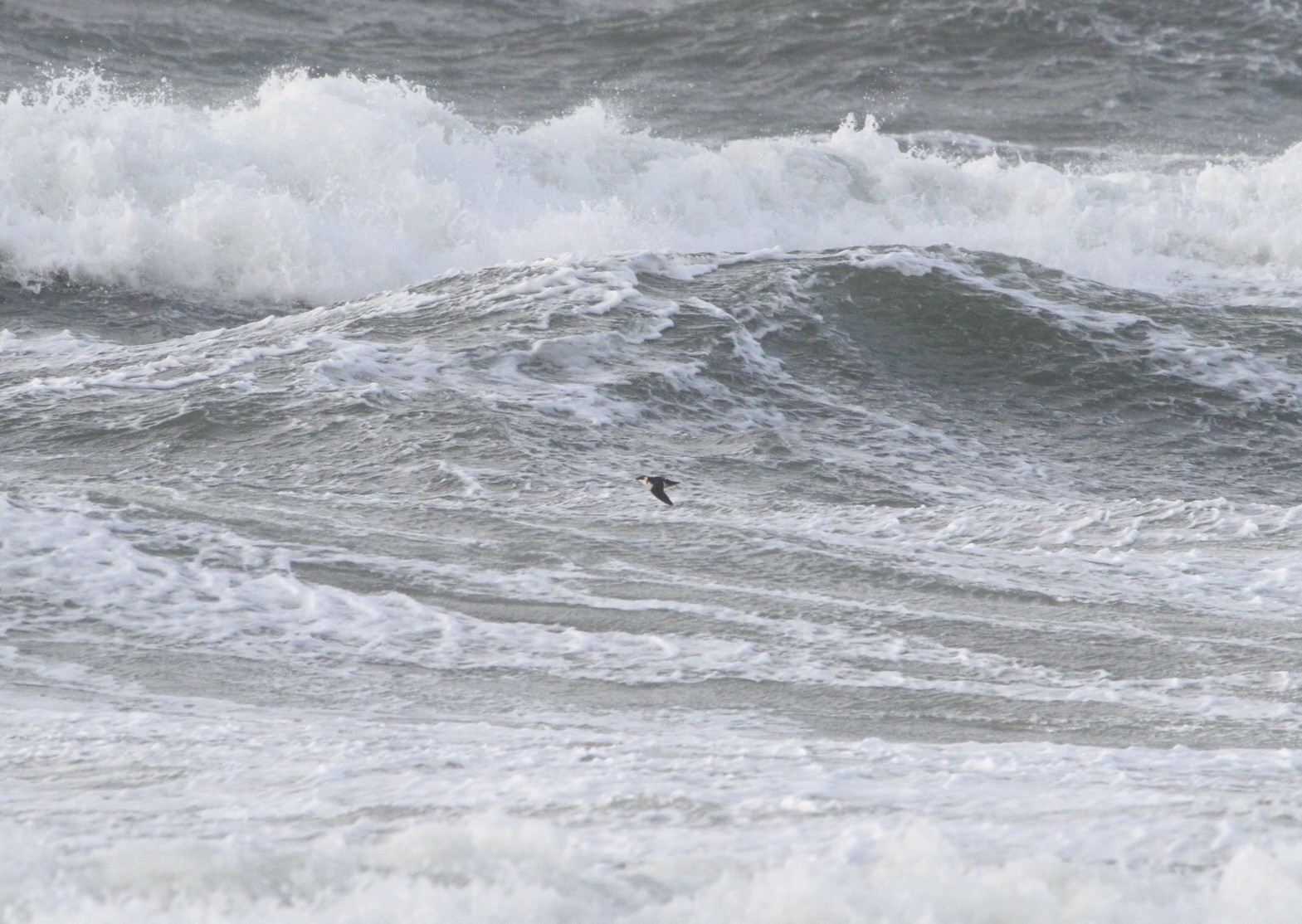
- En af dagens søkonger, foto; Mikkel Bello
- SDP
Ringing
After a rainy start, the day turned out lovely, and so did all the birds we had in the net! After a slower beginning with a few wrens(gærsmutte) and blackcaps(munk), we got our first income of blue tits( blåmejse). At around 11h we had to say goodbye for now to our lovely ringer Anna Beluga. But before that, to soften the blow, we got another cuteness overload in long tailed tits (halemejse)! This was a nice surprise for Anna, as these were her last ringed birds at Blåvand for this season!
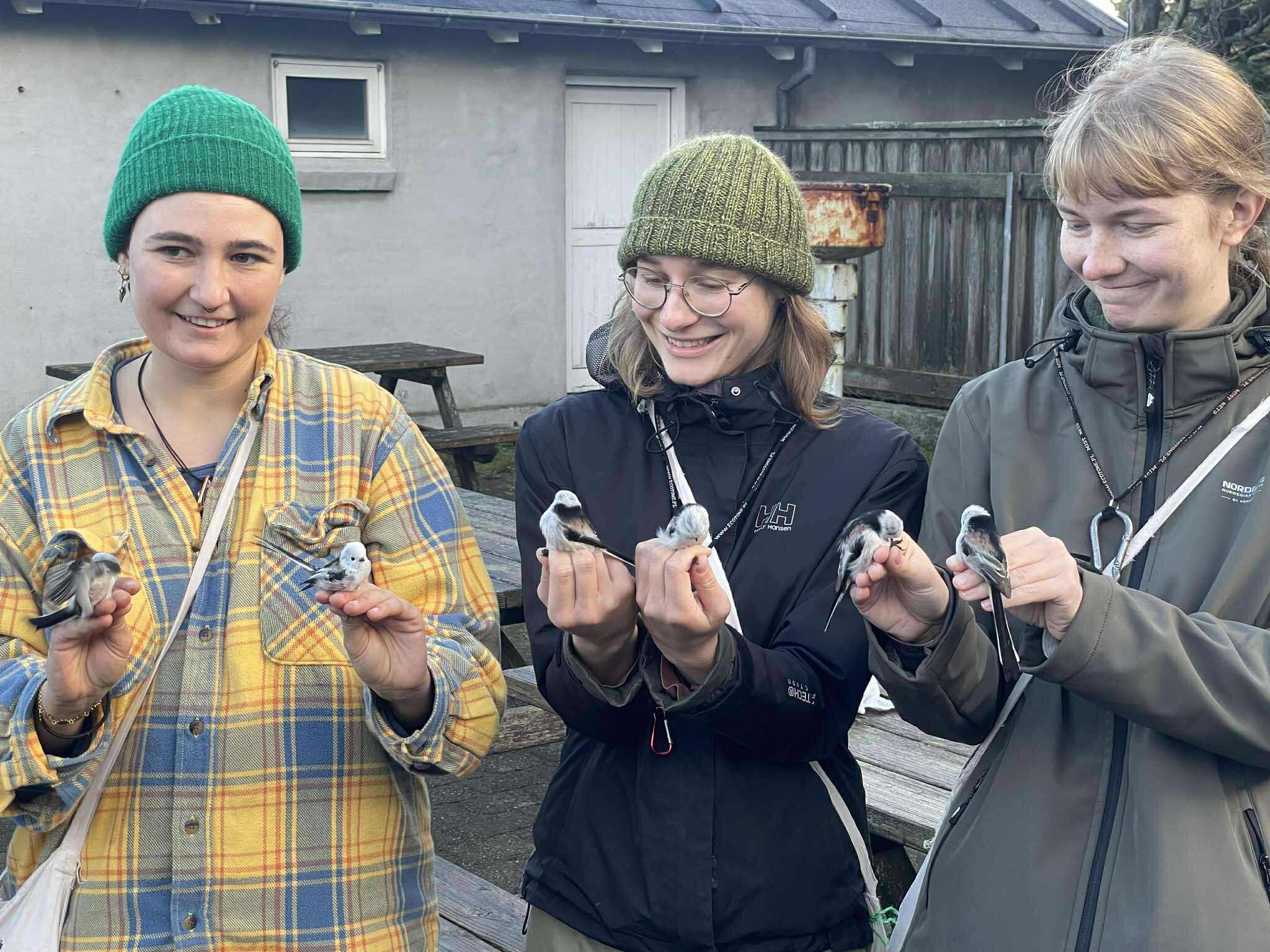
Lua, Anna and Mathilde releasing long-tailed tits
After the goodbye, we got a few more influxes in blue tits, great tits and more long tails! With a total of 79 ringed birds, it was another nice day in blåvand, before we had to close due to rain aproaching.
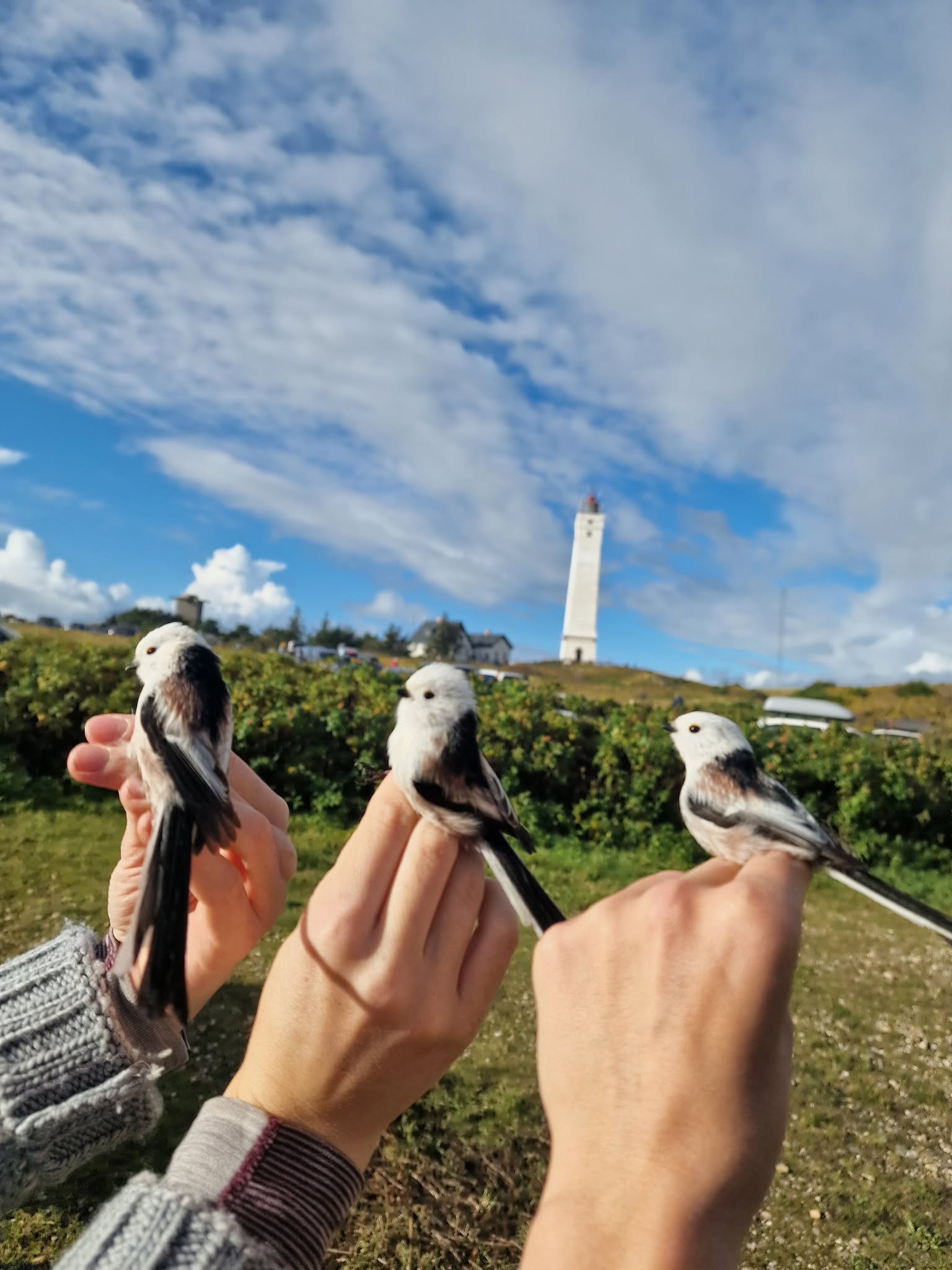
-LK
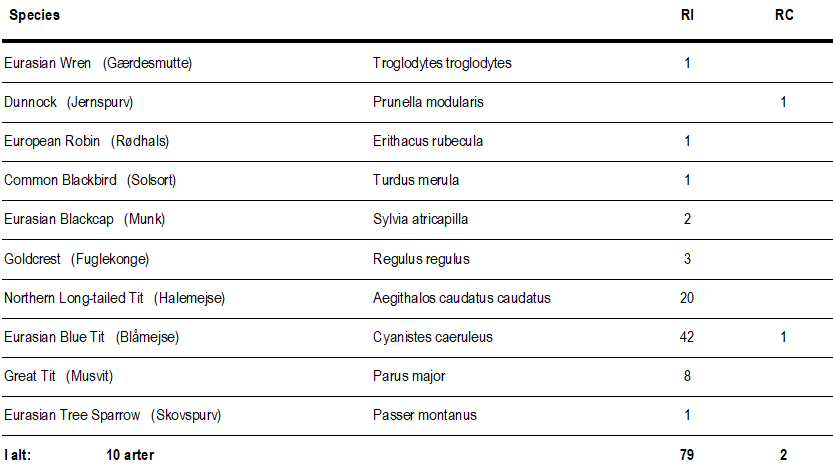
Folk på stationen: Lua Koplin, Sverre Dahl Porsgaard, Mathilde Lundt Larsen, Anna Beluga Gade-Jørgensen og Oliver Laursen, Mikkel Bello, Henrik Böhmer
Og så var der tomt
Morgenobs
Denne uge har været præget af en del regn, som også engang har resulteret i en tidligt afsluttet morgenobs. Ikke denne dag, fordi det blæste kun en mild 6 m/s i forhold til den anden dag med aflysningen. Men DMI havde også lovet regn i dag, og det skal jeg lige love for at der også kom regn. Fuglene kom lige så stille og roligt, indtil MEJSERNE KOM! ligepludselig kom lyden af godt 80-100 trækkende blåmejser. Vi (Henrik, Sverre og Oliver) frydede os ved synet af de mange trækkende fuglene. Fra Sverres lomme lød telefonen, det var Lua, den ene af vores ringmærkere, der kaldte og spurgte om hjælp til at pille fuglene ud af nettene da det begyndte at regne, og de havde netop lige fanget de blåmejser og musvitter der trak over hovedet på os. Henrik og Sverre tog derud og jeg var ene mand på hukket til at tælle, og så var der tomt. Regnen tog dog til, og paraplyen blev slået ud. Sortænderne fortsatte langsomt sydpå, da der foran en gammel sule, fløj en toppet lappedykker! Det er faktisk kun femte gang den ses officielt herude i år, selvom det er en almindelig art i de danske søer og fjorde.
Ringmærkning
I dag blev det 4 timer med ringmærkning, da tunge regnskyer satte en stopper for arbejdet ved 11 tiden. Vi havde en masse fugle i løbet af dagens 4 tørre timer. Lidt af de sædvanlige som gærdesmutte, munk og solsort. Og selvfølgelig… en hulens masse mejser (musvit og blåmejse).
Men et par små fugle gav lys til denne gråvejrsdag. Side om side var to rødtoppede fuglekonger i den ene net. Den ene en han, den anden en hun. Det var sjovt at kunne sammenligne de to. Præcis som hos de mere almindelige fuglekonger, kan kønnet genkendes på fjerenes farve på hovedet. Hunner er gule, mens hannerne har mere varmt orange fjer (selvom de til tider gemmer sig godt under de gule hovedfjer).
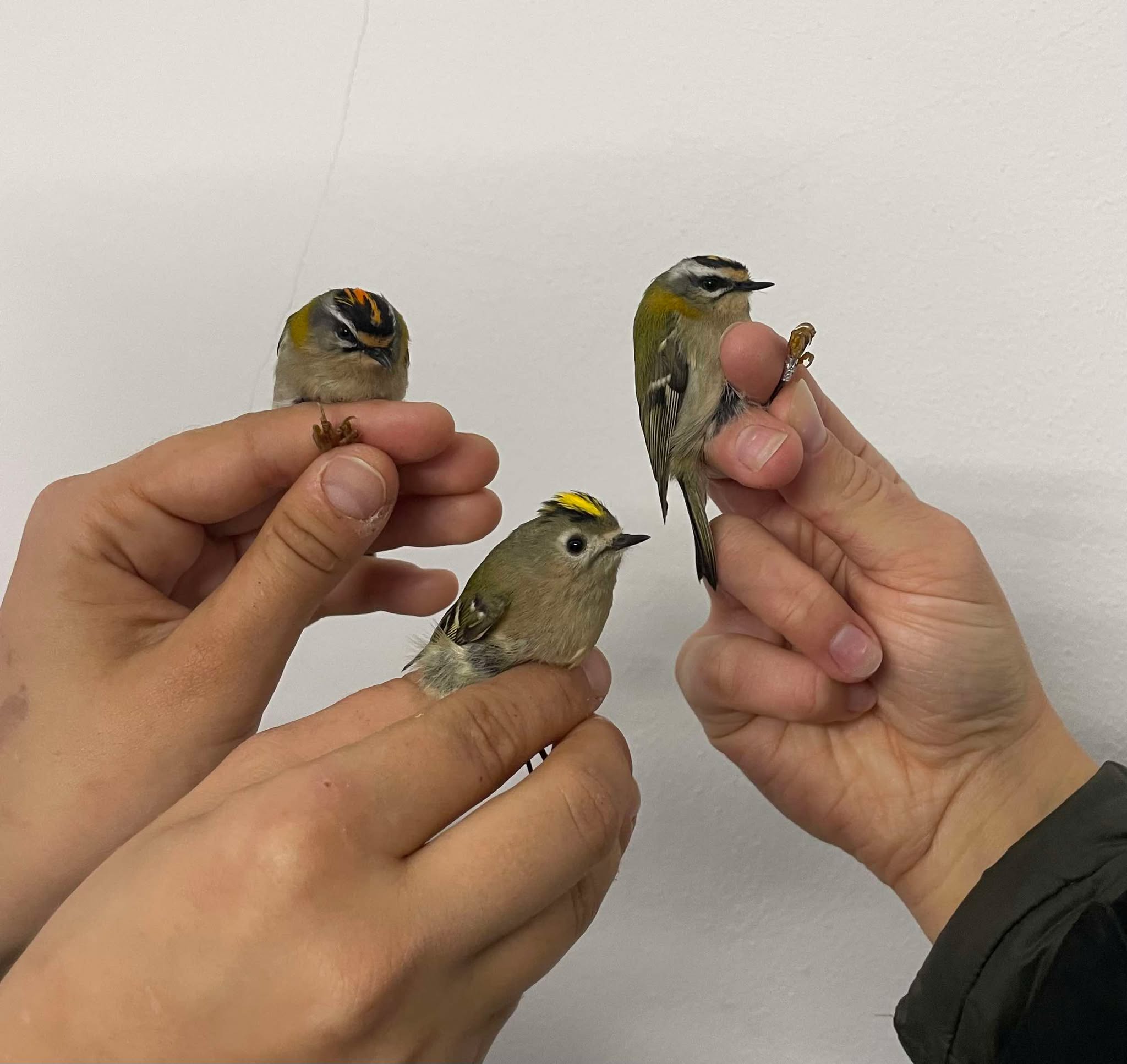
Bagved: rødtoppet fuglekonge han til venstre og rødtoppet fuglekonge hun til højre. Foran: Fuglekonge hun.
- AB
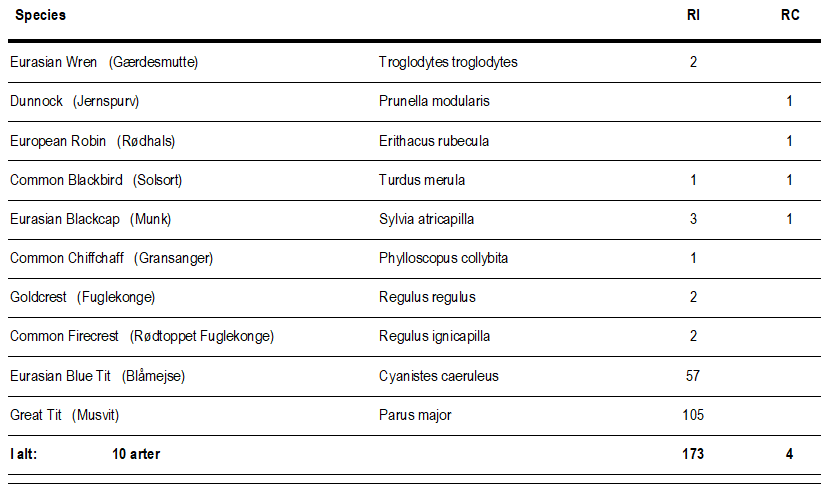
Folk på stationen: Lua Koplin, Sverre Dahl Porsgaard, Mathilde Lundt Larsen, Anna Beluga Gade-Jørgensen og Oliver Laursen.
Det kan øse det kan pøse
Morgenobs
Det der med at der ikke findes dårligt vejr, kun forkert påklædning holder ikke helt stik. For når det regner gider de færreste fugle at trække. Ja i dag var pænt vådt, men godt pakket ind i vandtæt tøj satte Oliver og jeg os ud på hukket for at tælle fugle. Vi nåede lige akkurat at gennemføre den første halve time og tælle måger inden himlen åbnede sig og vi blev slask våde. Hvis det regner mere end en millimeter per timer er observationerne uden for den standardiserede observation. Så vi vendte våde hjemad. Vi nåede dog at se både lidt ederfugle og 6 dværgmåger trække, inden teleskoperne blev for våde til at se igennem. Mens vi sjaskede hjemad nynnede jeg sagte for mig selv en gammel spejdervise
"Det kan øse, det kan pøse, det kan regne,
li’så meget som det vil.
Det kan plaske, det kan sjaske allevegne,
vi marcherer bare til.
Husk blot den gamle sætning:
Hold trit og retning i alt slags vejr.
Det kan man sagtens klare,
når man da bare har fedtelæ’r."
Ringmærkerne havde ikke net oppe i dag, så det blev ikke til så meget fra nogens side. Vi har hygget inde i stedet, og denne dag falder i kategorien "fyld" som er god at sammenligne med så man i sandhed værdsætter de gode trækdage. Dog stadig en god dag i det skønne Blåvand.
- SDP
Folk på stationen: Lua Koplin, Sverre Dahl Porsgaard, Anna Beluga Gade-Jørgensen og Oliver Laursen.
Det der kom ud af tågen
Morgenobs
Dagen startede i en grå og kedelig scene, der trods dette trak fine arter til sig. De første fugle der gjorde sig synlige var de altid trofaste sortænder og sandløbere, der som navnet indikere løb rundt dernede og fangede skaldyr. Pludselig, lavt bag de første klitter, fløj en lynhurtig skovsneppe frem, en art som man ellers kun ser kortvarigt inde i den dybe skov. Dværgmågerne kom stille og roligt foran brændingen og blev hurtigt væk i skopsfeltet, ja den lever op til sit navn. I går havde vi to steppehøge på hukket. I dag havde vi kun ét individ, men den var som altid velkommen, men sine fine gyldne farver og smalle vinger. De trofaste sandløbere fløj ligepludselig vildt for sig, og til hver sin retning. Da en vandrefalk kom lavt over stranden og gjorde kortvarigt rast, før den fløj videre på trækket. Efter morgenobsen, tog vi hjem og spiste frokost, og jeg (Oliver) tog ud i mosen i det stille regnvejr i håb om at finde mig en fugl eller to. Det startede lovende med synlige fuglekonger og gærdesmutter i kratene, hvorefter nogle tyskere med deres 3 store hunde gik lige forbi en enkeltbekkasin, der tryggede sig i græsset. Jeg ville ikke selv vide at den var der, hvis ikke det var fordi jeg stoppede op foran den, for at lytte efter fyrremejsen som igen kaldte ved den nordlige branddam, hvorefter bekkasinen fløj lydløst op og viste dens gyldne striber på ryggen. Lidt længere nordøst for den nordlige branddam, skræmte jeg en værling op der kommer til at give mig mareridt. Værlingen sagde nemlig som sangdroslen gør på trækket og ovenikøbet så havde den også en grålig overgump... Men den var pist væk og kunne ikke genfindes på nogen måde, så gad vide om det var dværgværlingen der sad i mosen?
Ringmærkning
4 fine nye fugle blev det til i ringmærkningen i dag. 4 unge hanner. 2 Munk med et tykt fedtlag og 2 Solsort uden det mindste fedt.
Imellem runderne og regnbyerne, beskæftigede vi os også med fugle, men af den mere kunsteriske og flade slags. Vi færdiggjorde et puslespil, som flere af jer der læser med, har haft fingrene i. I den seneste uges tid har dette puslespil beskæftiget husets beboere, og felttræffets gæster, i døgnets mørke timer. Både udnævnte puslespils ‘elskere’ og ‘hadere’ sad side om side, i håbet på at finde brikken med rødhalsens næb eller stærens bær. Nogle gik systematisk til værk, andre prøvede lykken med tilfældig 'roden rundt' i boksen med brikker. Brik for brik blev puslespillet lagt. Til lyden af rungende latter og under koncentreret stilhed.
Sammen gjorde vi det! Tak til alle der lagde en brik, delte en historie inspireret af puslespillets fugle eller kom med opmuntrende kommentarer undervejs. Sammenlagt mere end 20 timer og 10 personer, tog det er ligge ét puslespil af 1000 brikker. Motivets 11 arter, har alle været ringmærket i denne efterårssæson i Blåvand.
Jeg (Anna Beluga) ved at dagens ringmærkningstekst er lidt uden for normalen. Men jeg har lyst til at dele den oplevelse af fællesskab jeg ser, og oplever, hver dag her på fuglestationen- som bl.a. kommer til udtryk i et puslespil. Vi er mange mennesker, med forskelle i køn, alder, nationalitet og værdier, men vi har en ting til fælles… Fuglene!
Vores fælles fascination og kærlighed for de bevingede dyr, skaber en umiddelbar sammenhørighed, som gør interessen for fugle endnu mere betydningsfuld!
-AB
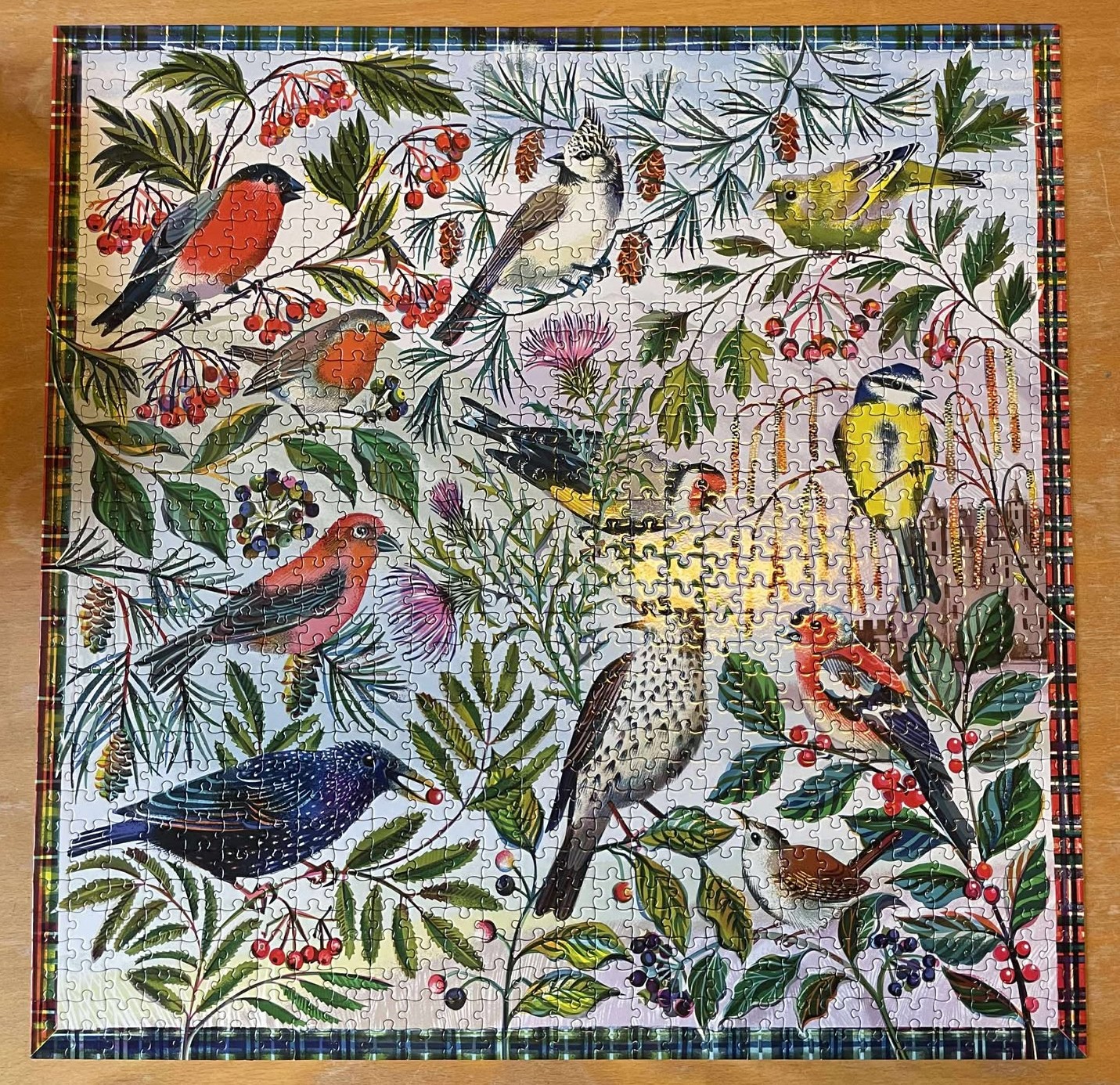

Folk på stationen: Lua Koplin, Sverre Dahl Porsgaard, Anna Beluga Gade-Jørgensen og Oliver Laursen.
Steppehøge i det grå
Morgenobs
Vinden fortsætter i SØ med mellemstyrke. 8-9 meter i sekundet lyder dejligt til træk. Vi havde lidt andetræk i form af spidsænder og lidt pibeænder, dagens and var dog en lækker havlit han som lagde sig midlertidigt til rast. Dagen var relativt stille indtil kl lidt over 9 hvor jeg (Sverre) spotter en kærhøg komme trækkende omkring revet. Jeg råber den hurtigt ud til mine medobservatører og Oliver spotter straks en hvid krave på fuglen... STEPPEHØG! Jeg genfinder den i skopet og ser smal hånd og sort arm, det er en klar steppehøg. Den redder uden tvivl en ellers halvstille morgen kun sparsomt krydret med alliker og lidt gulspurve.
Efter morgenobs tog Mikkel Bello og Oliver Laursen ud at kratluske. Jeg vælge rikke at tage med. Stor fejl. De kalder endnu en steppehøg ud, kl. er nu 13.20 så det er en ny fugl. Jeg sprinter ned til mosen og fuglen bliver heldigvis i området og svinger endnu en omgang over flokken. Oliver snupper et ganske fint billede til dokumentation. Alle er glade. Vi lusker i fællesskab videre og hører en fyrremejse ved den nordlige branddam. Derefter begynder regnen og vi vender glade og våde hjem til stationen. Endnu en dejlig og yderst god dag i Blåvand:)
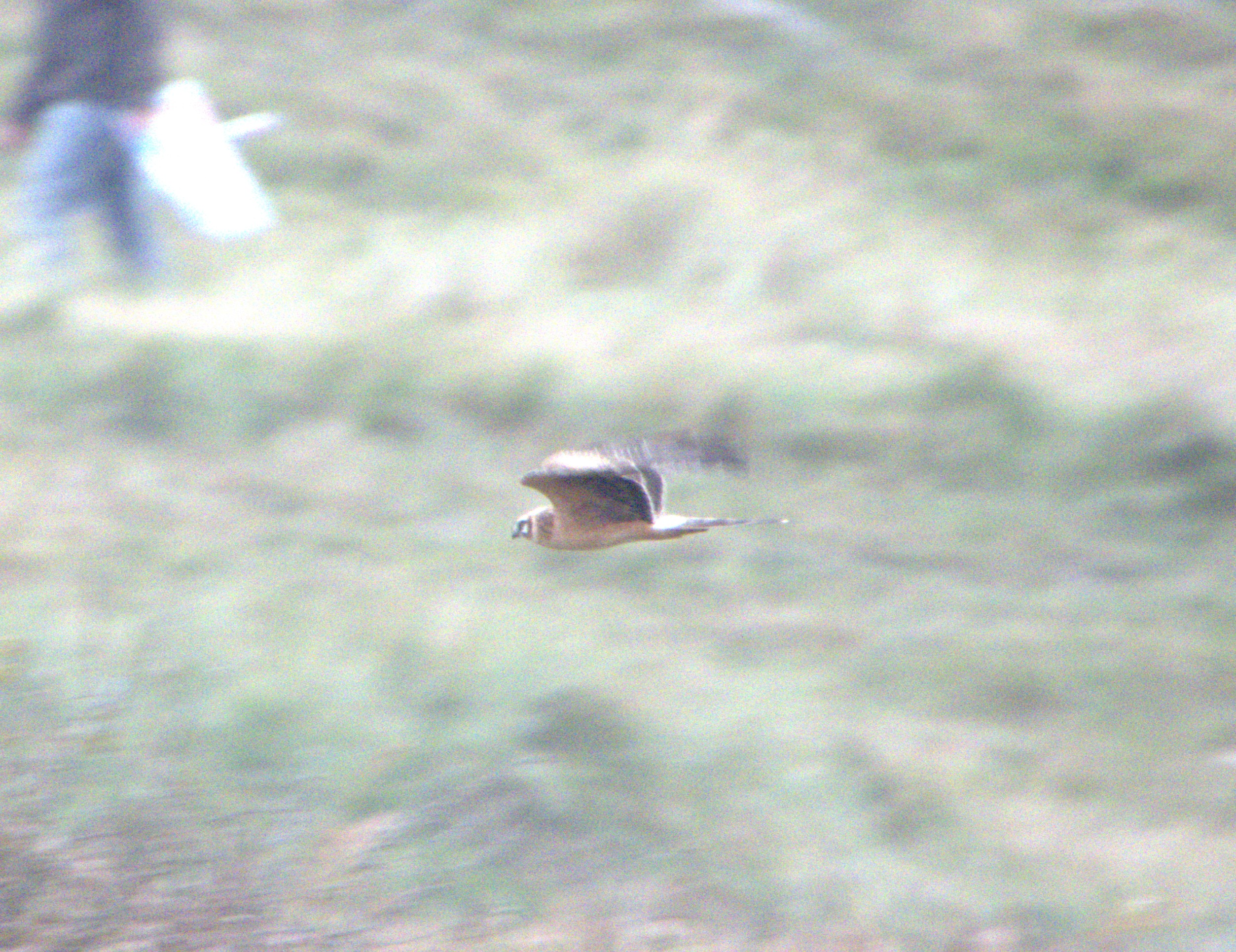
Steppehøg over mosen. Foto: Oliver Laursen.
- SDP
Ringmærkning
Dagen gryede med en smuk solopgang, mens vi satte net op og mærkede vinden tage til. Jeg kunne ikke høre fugle kalde i træerne, som der ellers ofte på de travle dage er. Således begyndte en stille dag - der ledte til syv nye fugle og fem genfangster. Det tyder på, at mange fugle enten har trukket eller sidder og trykker sig. I det fugtige vindrige vejr var der ikke mange småfugle på træk forbi haverne, deraf var genfangsterne flest fugle fra den seneste uge, der er blevet hængende i området.
Af nye fugle var den talrigeste munk, alle fire 1k han munk, næsten som fløj de i en flok - The Beatles med grydehår. Dagens fugl i ringmærkningen var dog en ny 1k vindrossel, da jeg nyder at se at drosseltrækket for alvor er godt i gang.
Midt på dagen blev det mere og mere vådt og gråt - som en truende skygge rullede regnen ind over os. Af de få fugle, der endnu var i bevægelse, var flokke af stære, så vi lukkede net og satte os til at holde øje med Helgoland-fælden, hvor vi satte stærekald op på højtaler. Det gav desværre ikke noget resultat, men et værdigt forsøg på at fange stære, der må gentages en anden gang.
- MLL
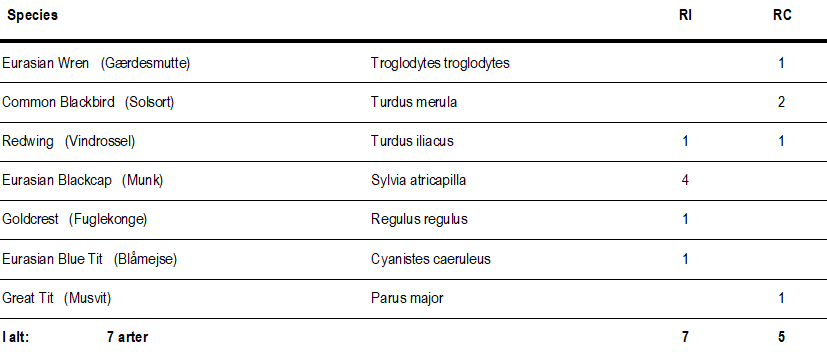
Folk på stationen: Lua Koplin, Sverre Dahl Porsgaard, Mathilde Lundt Larsen, Anna Beluga Gade-Jørgensen, Oliver Laursen, Mikkel Bello
Jackdaws and manual labor for our new observer
Morgenobs
Today is unfortunately the last day with visitors in the house and at the observation. We were however still alot of nice and competent people at the obs. The amount of skilled observers combined with a great south-easterly wind gave me plenty of nice birds to note down. WE HAD 647 EIDERS AT THE OBS! That is quite a lot for this area, and we are very pleased with that. Add some ducks, 12 sparrowhawks, five hen harriers 66 buzzards, a red kite, 750 jackdaws, 200 rooks, 2900 bramblings and chaffinches and you've got yourself a recipe for a WONDERFUL day. Even though we did not have a lot of rarities, it have been a really fun and entertaining day at the observations post:)
Later in the day Oliver Laursen arrived at the staion. He is going to be my co-observer til the end of the season in mid november. I look forward to having him at the obs. Oliver has been an observer here for a couple of weeks before, so instead of showing him around we gave him some manual labor straight away and started chopping firewood and clearing out trees that had fallen down and. A great and hardworking day here i Blåvand.
- SDP
Ringmærking
The morning started off not as cold as the day before, but it did get colder throughout the day, which we noticed also within the bird activity around the nets. Most observed birds were enjoying the warm sun up on a cozy tree, rather than hopping around foraging or doing long distant flights. We did however still catch a nice variety of wonderful species and a few flocks of blue tits and great tits with a few single coal tits. The most beautiful bird was this dashing tree Sparrow, always a pleasure!
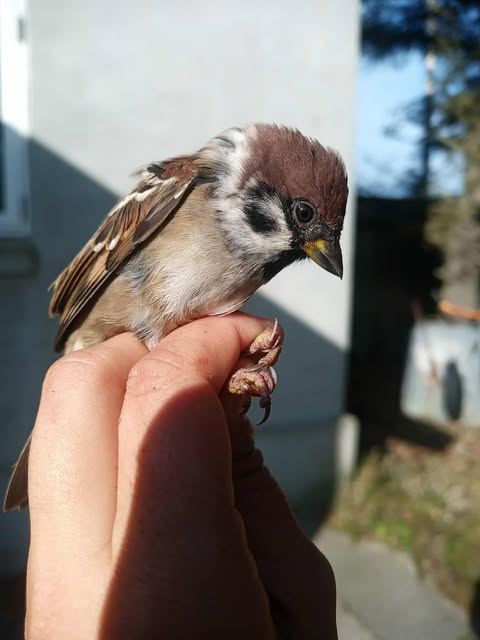
- Tree sparrow (skovspurv)
Folk på stationen: Lua Koplin, Sverre Dahl Porsgaard, Mathilde Lundt Larsen, Anna Beluga Gade-Jørgensen, Andreas Pedersen, Oliver Laursen samt gæster i forbindelse med Felttræf
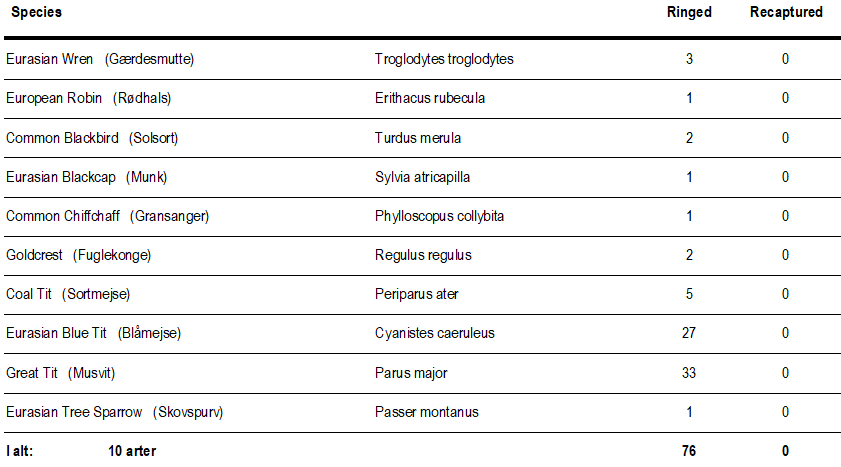
Catching leaves- Pallas leaf warbler!
Morning Obeservations
The wind died down and its getting cold! Two meters per second from east, ZERO DEGREES CELSIUS and thirty birdwatchers. The day brought nice numbers of eiders (ederfugle, roughly 300), mostly males goin north. We also got a lot of gray geese (grågås, 200) some jackdaws (allike 200), rooks (100), crows and some overflying finches and larks and stuff like that. Also starlings. Not a bad day and quite intertaining. The most interesting birds were a great crested grebe (toppet lappedykker) and three lapwings (viber). After the observation i joined the ringers for a couple rounds.
In the evening Anna Beluga, Lua, Andreas, Mikkel Bello and I went for a trip to the military heath area to look for wolves. Well prepared after the presentation from Kent Olsen we were ready to find some beautiful grey beasts. We quickly saw some footprints in the sand, but no actual wolves, Mikkel did however spot a eurasian great horned-owl (stor hornugle). And we saw both cranes and red dear. What a wonderful day!

- Wolve footprints and Sverres hand for scale
- SDP
Ringing
Today, as we had expected, the birds in the nets were plenty and quite special! We started the morning with some interested young birders joining us on the first 3 rounds, to observe and learn the in and outs of ringing birds. We had a few different thrushes to compare, which made for some great pictures and lessons! The same with the bullfinches and chaffinches, which show very easy identifiable sexual dimorphism. Then numbers started to pick up a little bit with several tit swarms, including long tailed tits! And just as we were getting excited about today's numbers, we caught the most amazing little bird, the Pallas leaf-warbler!
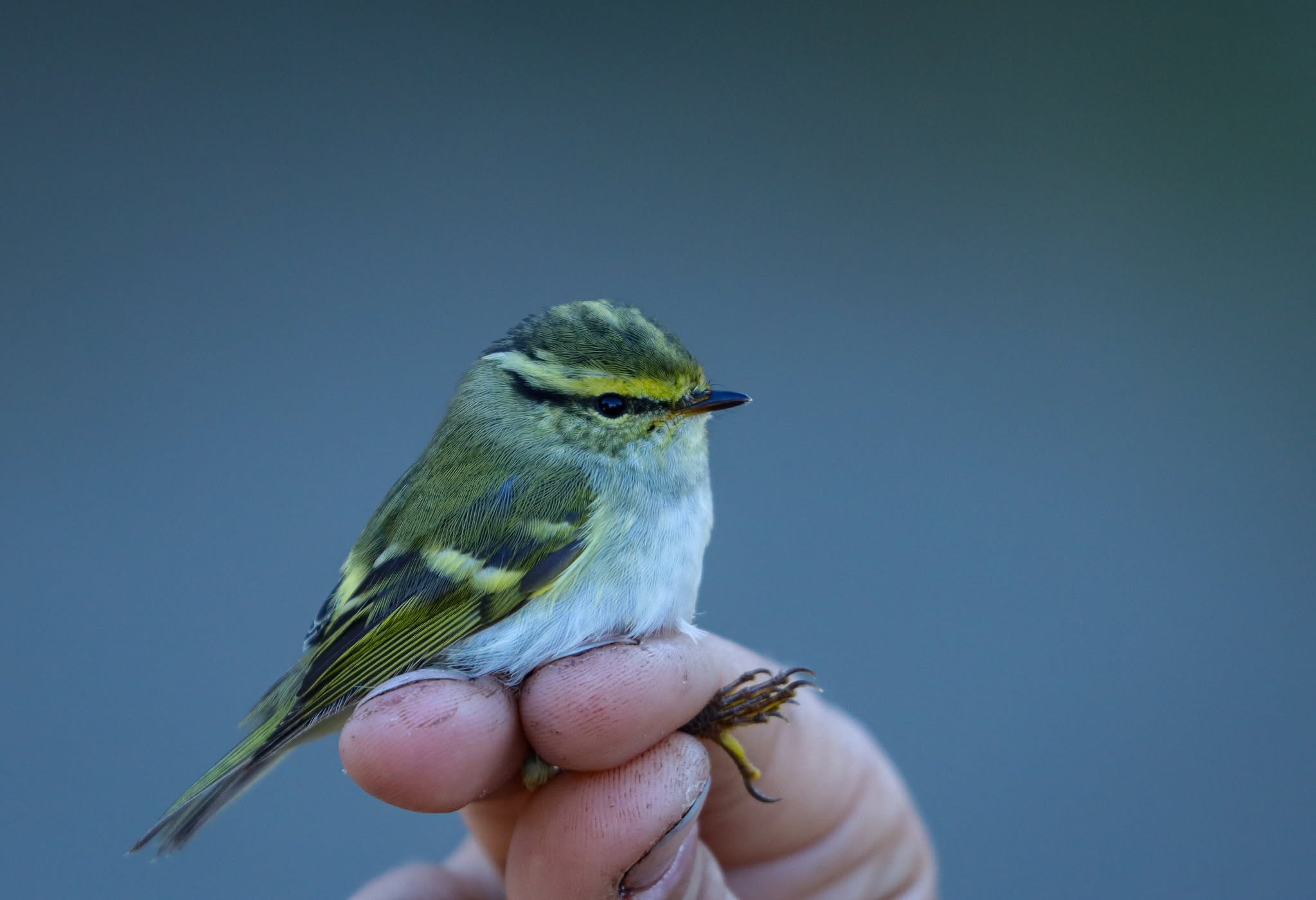
This tiny little warbler was also a perfect people magnet, so we got a lot of visitors at the station to witness this amazing moment!
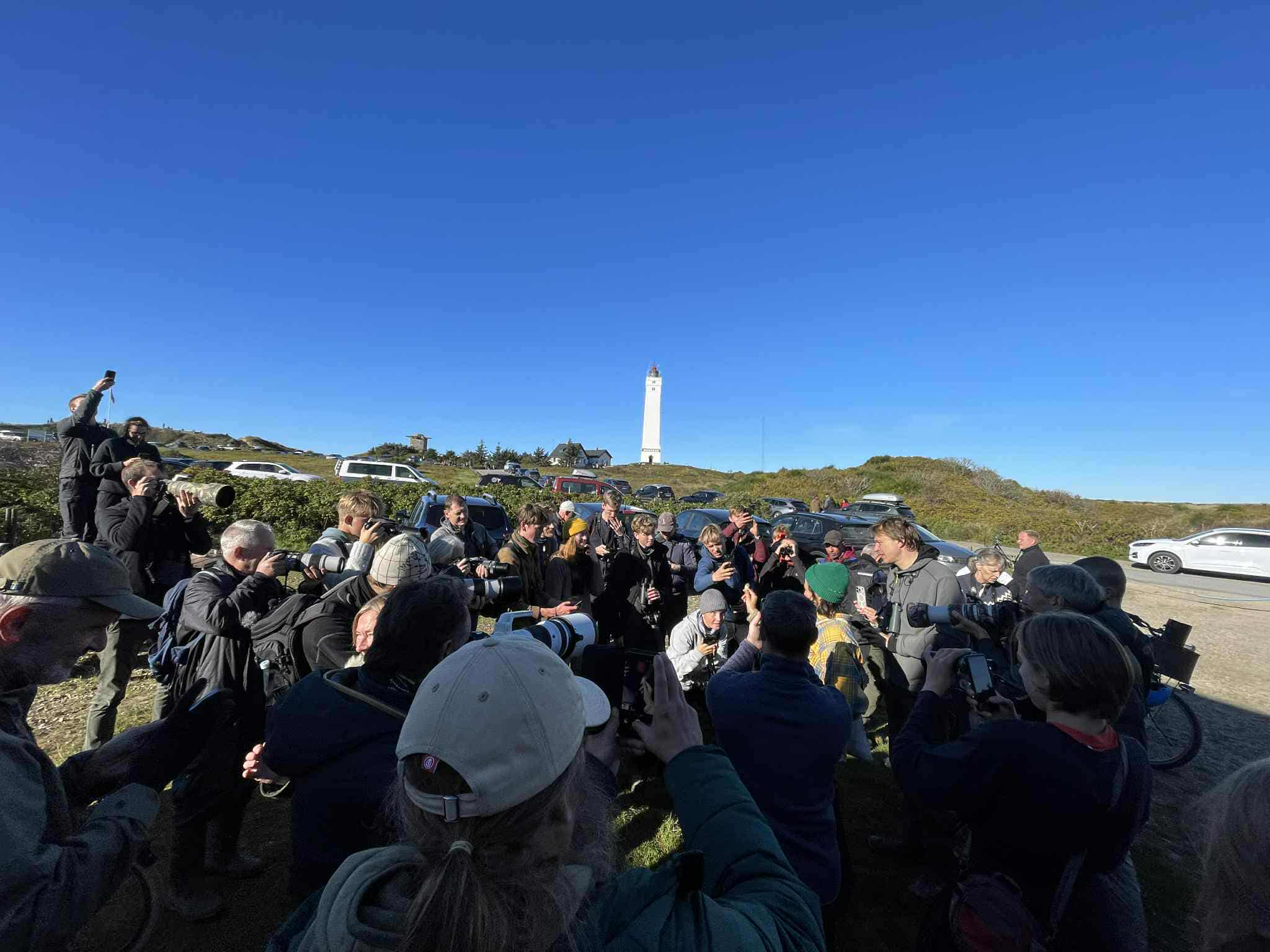
Bird numbers stayed high until we caught 2 other unusual birds in the net, a young male siskin and then a beautiful common starling which fascinated everyone to see it!
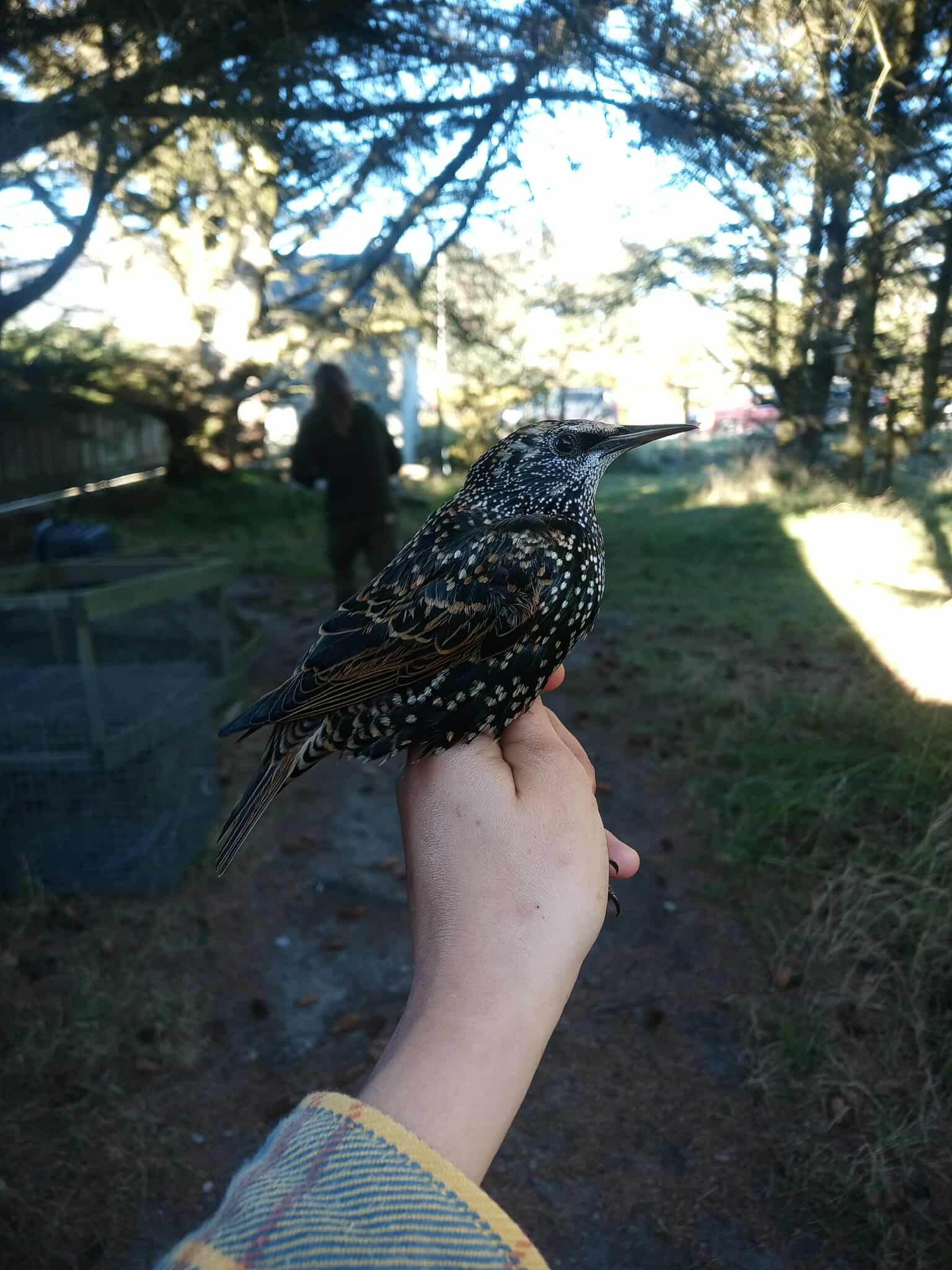
It was an amazing day for ringing, with close to 200 birds including some very special individuals and hopefully more to come tomorrow!
-LK

Folk på stationen: Lua Koplin, Sverre Dahl Porsgaard, Mathilde Lundt Larsen, Anna Beluga Gade-Jørgensen, Andreas Pedersen samt gæster i forbindelse med Felttræf



